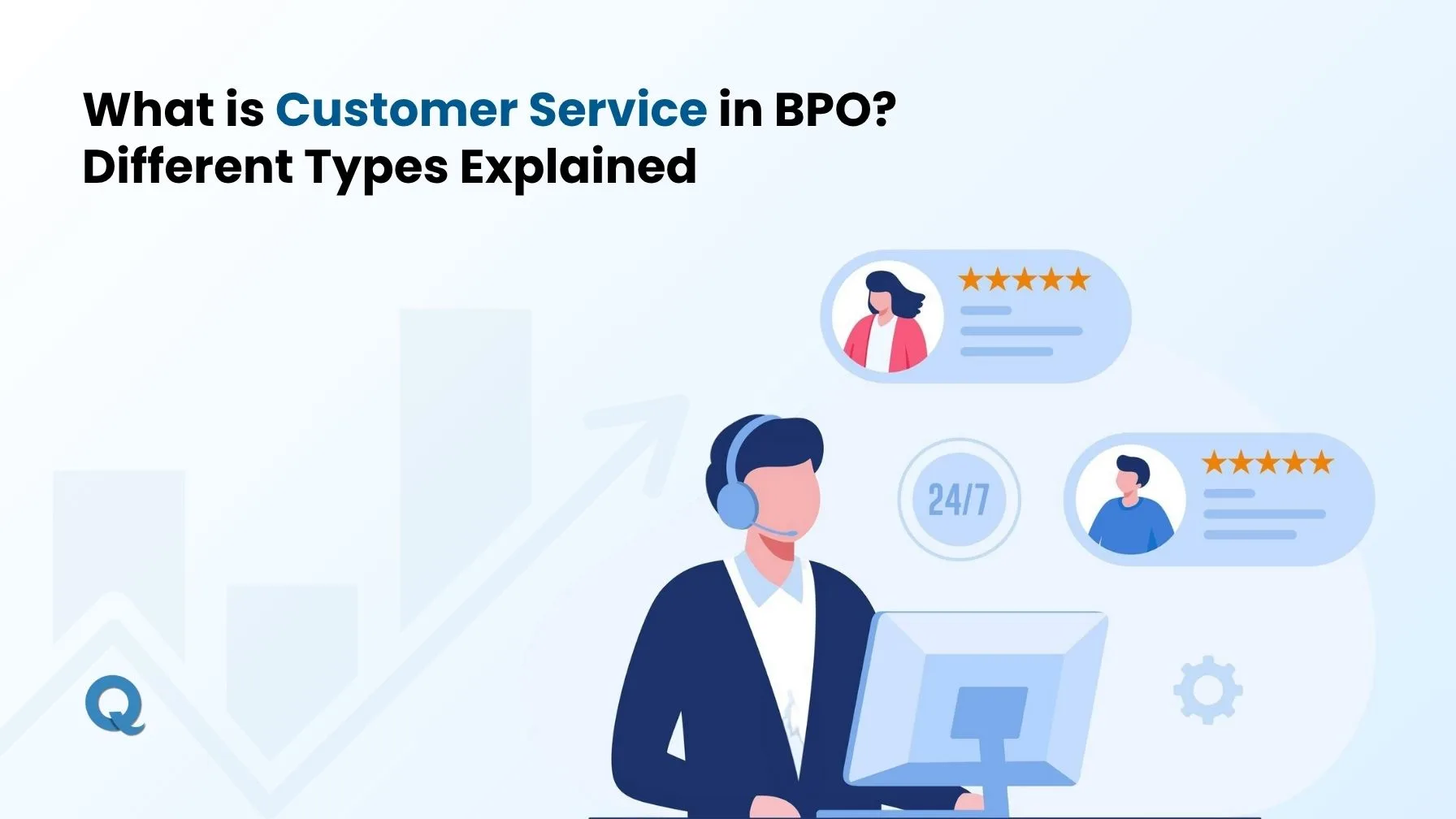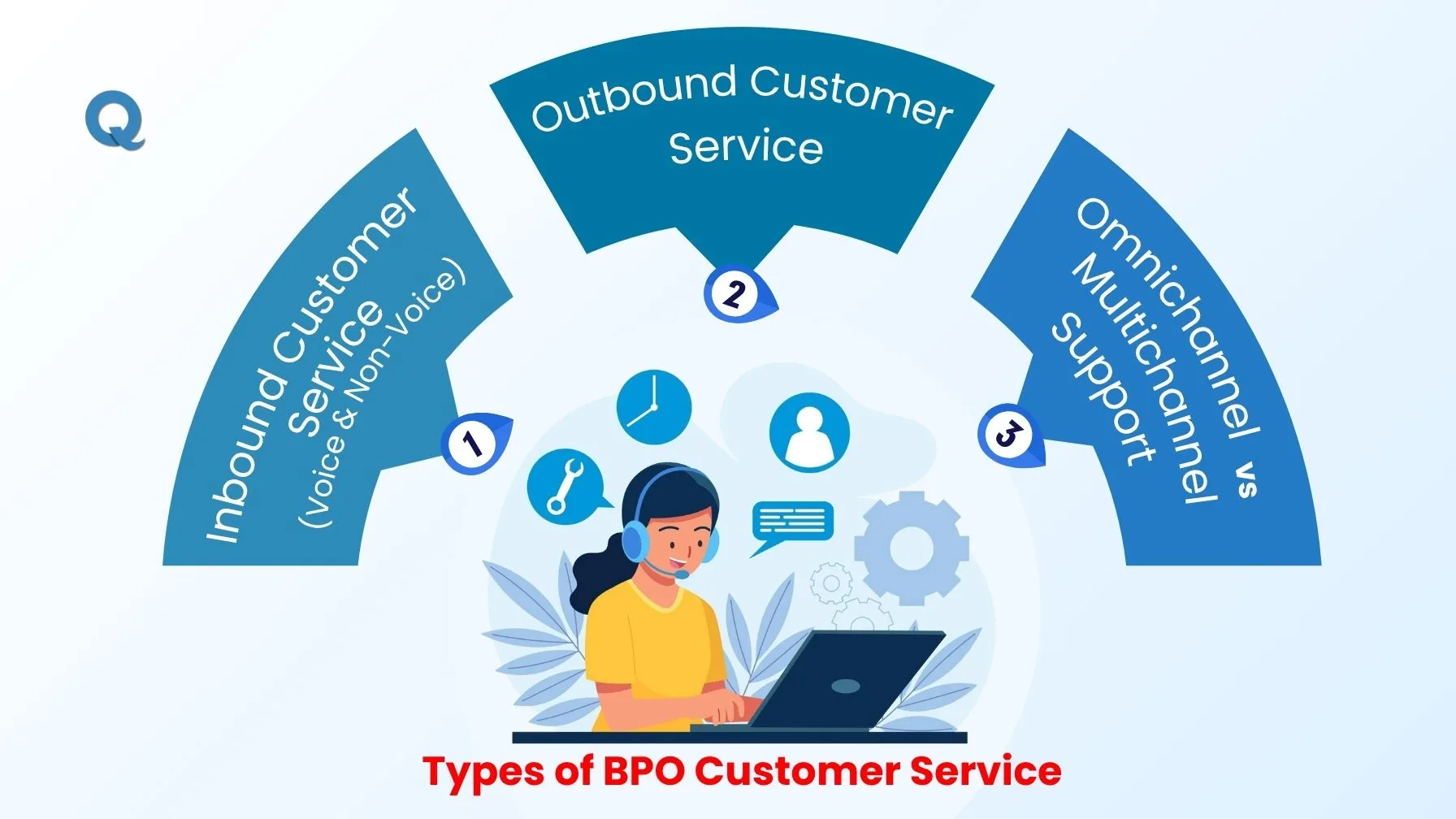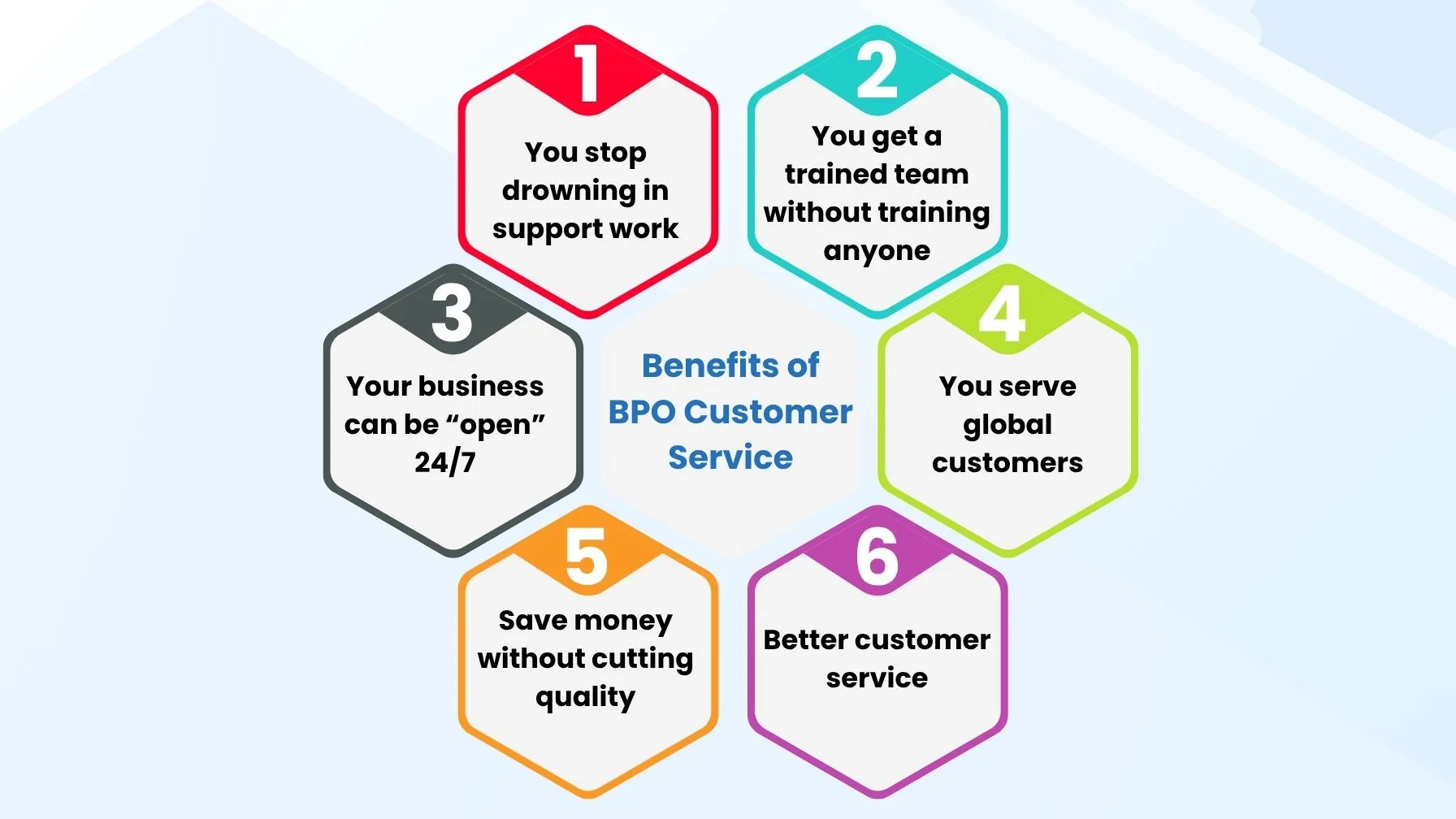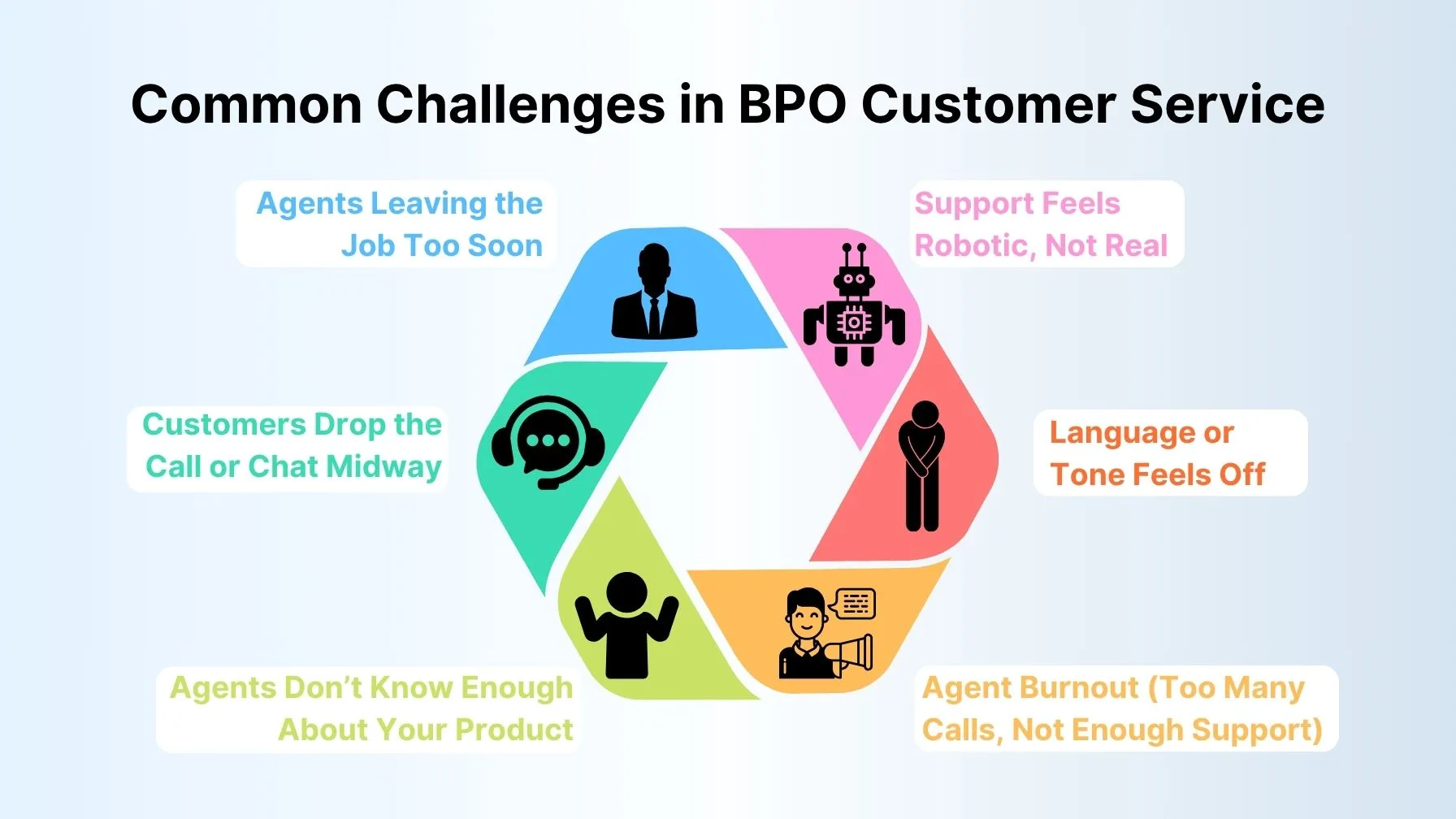What is Customer Service in BPO? Different Types Explained
Explore customer service in the BPO industry & its impact. Learn about different types of BPO customer service and customer support challenges & solutions.
Author: Abhilash Dama
Explore customer service in the BPO industry & its impact. Learn about different types of BPO customer service and customer support challenges & solutions.
Author: Abhilash Dama

Customer service in BPO means handling customer interactions on behalf of another company through calls, chats, emails, or social media. It helps businesses offer support without managing it in-house. BPO teams are trained to address and resolve user issues, answer customer queries, and improve customer satisfaction, often working 24/7 across different time zones.
There are different types of BPO customer service: inbound support, outbound calls, non-voice services, and omnichannel handling. Each type serves a specific need based on how a business connects with its customers.
But this is just the surface. If you want to really understand how customer service in the BPO industry works (and why big brands trust BPOs), keep going.
Customer service in a BPO means handling all aspects of customer tasks like calls, chats, emails, and social messengers for another company. They're the bridge between a customer and their needs, working on behalf of someone else. But it gets more interesting than just a question-and-answer.
Customer service operations in BPO aren’t just about solving problems. It plays a direct role in how a business grows. Here’s how:
When people get the help they need quickly and politely, they don’t look for third-party service elsewhere. Customer service BPOs help businesses stay available 24/7, which means general customers feel supported anytime they reach out. That builds trust, and trust builds loyalty.
Every interaction your customer service BPO team handles is a reflection of your brand. When it’s done right, customers talk about it. Online reviews go up. Word-of-mouth spreads across various channels. And that drives more sales without spending extra on ads.
Good customer service prevents customers from leaving. In fact, a Deloitte study found that 62% of companies see customer experience as a strong competitive differentiator directly tied to retention and long-term revenue.
With BPO teams handling support, your internal team can focus on product development, strategy, or marketing. That’s how startups grow into global brands, by delegating customer care to experts who can manage it at scale.
So it’s not just phones and scripts; it’s a serious service quality engine for business growth.

Running customer support service in-house sounds great until your team gets buried under tickets, your phones ring off the hook, and you're scrambling to hire, train, and manage agents just to keep up.
That’s where BPO (business process outsourcing) steps in. Here’s exactly why so many companies choose to hand over their customer service to a BPO provider:
Normally hiring full-time support staff, setting up infrastructure, and running a high-quality customer team 24/7 isn’t cheap. Outsourcing slashes that cost big time.
And when your business grows fast (or hits seasonal peaks), BPOs help you scale up or down easily without going through long hiring cycles.
Your customers might be in different time zones or just night owls. Either way, they expect quick replies.
BPO service providers often run support around the clock, so you never miss a message, call, or complaint. Plus, they can offer support in multiple languages, which is a huge win if you’re aiming for a global customer base.
This kind of availability enhances customer satisfaction and builds serious trust. No more "we’re closed" frustrations.
Most BPOs live and breathe excellent customer service. Their agents are already trained, their systems are ready, and they use top-tier tools like CRM platforms, AI-based chatbots, and sentiment analysis software.
You get instant access to:
So, in short, outsourcing support helps companies save money, match customer expectations, and grow faster. That’s why startups and even massive brands trust BPOs with one of the top important parts of their business: customer experience.
Not every customer reaches out the same way, and not every business handles support the same either. This is the reason BPO customer service exists in various forms:
Whether it’s someone calling in, chatting from an app, or getting a sales follow-up call, each interaction falls into one of three main categories. And understanding them helps you build the right support flow for your business.

This is when customers come to you.
Your customers might be calling, texting, or emailing because they need something, maybe help with a product, maybe a refund, or maybe just someone to explain things clearly.
Still remains one of the most used forms of assistance. When people want to talk to a real person (through inbound call centers), voice support is what they go for. It's especially important when the problem is urgent or emotional.
Examples: Complaint calls, account issues, technical support
Tools used: Softphones, IVR systems, CRMs
Some customers prefer messaging, it’s faster, quieter, and fits into their day better. That’s where chat, email, and social support come in.
Examples: Live website chat, email queries, WhatsApp messages, Instagram DMs
Tools used: Chat widgets, email ticketing, social inbox platforms
Now your BPO process team is reaching out to the customer.
This could be a sales pitch, but it’s not always about selling. It could be checking in after a purchase, asking for feedback, or reminding them of an appointment.
Why it matters: It keeps customers in the loop and shows that you care.
Used for:
Outbound helps reduce drop-offs and keeps your relationship with the customer alive even after the sale is done.
This is where support becomes seamless, or maybe not.
You solve customer queries via multiple platforms like email, phone, and chat, but they don’t talk to each other. It’s like having multiple doors to your shop, but no one inside knows who entered through which one.
Problem: Customers often need to repeat themselves when changing platforms.
Everything is connected. Your BPO agent sees a complete history of the customer’s interactions across all platforms.
Example: A customer starts a chat about a refund, then emails you later. The agent replying to the email sees the earlier chat, so there’s no “Can you explain again?” moment.
Omnichannel support feels smooth, personal, and modern, and customers love that.
Here’s a simple way to understand the differences:
| Type | What It Does | Channels | Purpose |
|---|---|---|---|
| Inbound (Voice) | Responds to customer calls | Phone, IVR | Handling customer queries |
| Inbound (Non-Voice) | Handles messages from customers | Chat, Email, Social Media | Fast replies, async support |
| Outbound | The company reaches out to customers | Phone, Email, SMS | Follow-ups, sales, feedback |
| Multichannel | Support across different platforms | Phone, Email, Chat, etc. | Covers more ground |
| Omnichannel | Connected support across all channels | All combined in one view | Best experience |
Let’s say you run an online electronics store.
Someone calls to ask about a service delivery - That’s Inbound Voice.
Another customer chats about products or services return - That’s Inbound Non-Voice.
You follow up with a discount to a past buyer - That’s Outbound.
You offer support on WhatsApp, email, and phone - That’s Multichannel.
But if every agent sees the same history no matter where the chat started - That’s Omnichannel.
When your BPO offers the right mix of support types, you serve customers better. You’re reachable in the way they prefer, delivering good customer service that feels faster, smoother, and more efficient.
And in today’s world, that’s the difference between someone becoming a loyal customer or bouncing to your competitor.
When a company outsources its customer service, it’s not just handing off the phones or chats. It’s trusting someone else to speak directly to their customers. That’s a big deal. And for it to work properly, a few things need to be in place on both sides.
If you’re thinking about outsourcing your customer service, don’t just go with any random BPO that says they can handle calls and chats. It’s not about having people just “answer the phone.” You need a team that actually knows what they’re doing and a setup that helps them do it well.
Here’s what really matters behind the scenes:
This feels a bit normal, but it’s the most important thing.
You need agents who get it. Someone’s calling in angry, someone else is confused, and another person just wants a quick update. A good support agent knows how to stay cool, listen properly, and speak like a human - not like a robot reading from a script.
Great BPOs don’t just throw people into seats. They train their teams to understand tone, timing, and how to solve problems without sounding fake.
Even the best support agent can’t help you if the system crashes in the middle of a call. Or if the chat freezes. Or if the software lags and customers have to keep repeating themselves.
Ask your BPO what kind of tools they use. Do they have backups if something fails? Are their systems fast and stable? This thing matters more than you think, because when the tech fails, your customers feel it first.
Let’s say a customer called yesterday and now they’re messaging you on Instagram. If the agent handling this new message has no clue about the earlier call, the customer ends up repeating the whole story. Again.
That’s annoying. And you don’t want that.
A good BPO connects everything like phone, chat, email, and social media, so every agent sees the full story in one place. That way, the support feels smooth and personal, like you're already in the loop.
So... how do you know it’s actually going well?
Well, you start by asking a few simple things that actually matter to your customers.
If your BPO is already watching these issues, it's a good sign.
If they’re not, or if they can’t answer these clearly, that’s your signal to switch or look deeper.
To really know how your BPO is doing, you’ve got to track what’s happening behind the scenes. Below is a simple table that lays it all out so you can spot what’s working and what needs a fix.
| Metric | What It Means | How It’s Measured / Value | Health Status |
|---|---|---|---|
| First Contact Resolution (FCR) | Issue resolved in first interaction, no follow-ups needed | (Resolved on 1st contact ÷ Total contacts) × 100 | Good: Above 70% |
| Average Handling Time (AHT) | Total time per interaction (talk + hold + wrap-up) | (Total talk + hold + after-call work) ÷ Number of calls | Good: 4–6 mins (depends on industry) |
| Customer Satisfaction (CSAT) | Post-call rating on service satisfaction | (Sum of survey scores ÷ Number of surveys) × 100 | Good: 80% or higher |
| Net Promoter Score (NPS) | Measures loyalty and likelihood to recommend | %Promoters (9–10) – %Detractors (0–6) | Good: +30 and above |
| Response Time / Wait Time | Time before a customer gets a response or agent | Average time to first response or call pickup | Good: < 1 minute (chat/call) |
| Abandonment Rate | % of customers who leave before being helped | (Abandoned calls ÷ Total inbound calls) × 100 | Good: Below 5% |
| Service Level Agreement (SLA) | Predefined goal between client and provider | e.g., 80% of calls answered within 20 sec | Good: SLA met consistently |
You can have the best BPO, the smoothest tools, and a super-friendly support team, but none of it works long-term if no one’s actually checking what’s going on.
If team leads never listen to a call or read through a chat, how can anything improve?
This is where real quality gets built, through feedback, small course corrections, and quick chats with agents to say, “Hey, that could’ve been handled better.”
And this is exactly where Qoli comes in.
With Qoli, you don’t have to wait for someone to manually review random calls once in a while. Qoli automatically records and organizes all your support calls, so you can hear exactly how your customers are being treated.
It’s all there. Instantly.
You can review calls anytime, leave feedback, or even send examples of what great sounds like without sitting through hours of recordings. That means better training, faster corrections, and a support experience your customers will actually love.
If you're outsourcing your customer service, but you're not hearing the calls yourself... you're flying blind.
With Qoli, you stay in control without micromanaging.
The whole point of outsourcing customer service is not just to “save time” or “cut costs,” like every blog says. Sure, that’s true, but the real benefits go deeper, and they show up in ways that actually affect how a business runs every single day. Here's how:

If you're running a growing business, handling every call, message, and complaint in-house can burn your team out fast. One issue turns into five follow-ups. When you pass that work to a BPO, you finally free up time to focus on bigger things like fixing your product, scaling your offers, or checking out the latest tools and technologies.
You don’t have to teach them how to talk to customers. You don’t have to write long manuals or sit in on practice calls. The BPO has already done all that. You just hand over what your business does, and they take care of the rest.
And when you work with a good BPO? Their agents won’t sound like robots. They’ll talk to your customers like real people, and as a bonus, 86% of customers say talking to a human agent instead of a rigid script leads to a better experience.
Let’s say a customer in London messes up their password at midnight India time. With a BPO, help is available right away without any delays. And that pays off: 75% of consumers expect fast resolutions, often within the first hour.
Do you get messages from Spain, Germany, or the UAE? You don’t need to hire local support teams in all those places. Great BPOs often have multilingual agents ready to go. That means your business becomes global without any language barriers.
Let’s talk about money. Hiring someone full-time means salary, workspace, tools, benefits, and time spent managing them. BPO pricing is usually flexible, you pay only for what you need. No office chairs. No onboarding mess.
And because they already have systems in place, you don’t have to spend months building your own support setup from scratch. Studies show outsourcing support can cut costs by 30-45% compared to in-house teams. Meanwhile, brands focusing on customer experience often see 4-8% higher revenue than competitors.
A common fear is, “Will outsourced support be worse?”
The truth? Often, it’s better. Because these agents do this every single day. They're trained to handle angry calls, weird tech issues, or confused customers without panicking or passing the blame. In fact, a report from HelpScout mentioned:
This is why BPO customer service isn’t just “cheaper help”, it’s smarter help. It frees you, builds good customer relationships, protects your brand, and even boosts your revenue.
Outsourcing your support can be a smart move, but only if it actually works for your customers. The bitter truth is, even the best BPO setup can hit roadblocks if you’re not careful.
Before you fix anything, you need to know what’s really causing the problem. Here are the most common issues that can hurt your customer experience and what you can do about them from the start.

BPO jobs often have agents coming and going. People leave within months. Some quit without notice. So the team keeps changing.
New people take time to learn your product. So customers get slower replies, half-answers, or have to repeat themselves again and again.
Here’s what helps:
A customer starts a chat or call... then suddenly disappears. Maybe they got tired of waiting. Or maybe they just didn’t realize someone was about to reply. Either way, the moment’s gone. The agent ends up wasting time, the customer leaves without getting help, and it makes your brand look slow even if you were right there trying to help.
Fix it simply:
Sometimes agents do respond, but it feels like they’re just reading off a script. They don’t really get what your service is about. So when a customer asks for something a little different, things go sideways. The agent either gives the wrong info or sends the issue to someone else when it could’ve been handled right there. And that’s when customers start feeling like nobody really knows what’s going on.
Simple fix:
Some BPOs train agents to use stiff lines like “We regret the inconvenience caused” or “Please be informed…” Customers can feel they’re talking to a robot, not a person.
What to do:
The words might be right, but the feel is off. Maybe it’s too forma3. Maybe it's missing context. It just doesn’t sound like your brand. It can confuse or annoy customers. Especially if they’re used to a casual, friendly tone.
How to fix:
Support agents often handle back-to-back calls without breaks. They get tired, mentally drained, and emotionally detached. Burnt-out agents don’t listen well. They rush. They get irritated easily. And that shows in their tone.
How to prevent it:
Don’t just go with the first company that says they offer “24/7 support” and throws some pricing at you. That’s not enough. If you’re handing over your customer service, you need to know they’re going to handle it like it’s their own brand.
If they’re only telling you about how many calls they can take per day, that’s not useful. You need to know if they can:
Real BPO partners care about the same things you care about: keeping customers happy, calm, and coming back.
A lot of BPOs will show you fancy dashboards with graphs and green bars. That’s nice, but ask what’s behind those numbers.
And if they avoid the question or say, “That’s handled by the system,” you can switch to another option.
Things change. Some weeks you’ll need more agents. Some weeks, fewer. Ask them how they handle that situation. Do they make it easy, or do they lock you into fixed seats and long-term deals that don’t move with your business?
If they can't move with you, they’re not the right fit.
Not just “we use CRM.” Ask which CRM. Ask how it connects with your tools. Ask how your team will be able to see conversations if needed. You don’t want to be shut out of your own support.
Also check if they offer support on the same platforms your customers use. If most of your users are on WhatsApp or Instagram and they only offer phone and email, that's a mismatch.
Forget everything else for a second. When you talk to them, do they listen? Or do they just pitch and pitch? Are they more interested in showing you what they’ve done or understanding what you need?
Trust that instinct. It’ll save you later.
There’s no perfect template for finding the right BPO. But if something feels off during those early conversations, it usually is.
Take your time. Ask real questions. And if they speak your language, not just English or Hindi, but the way you think about your customers, you’ll know you’re in the right place.
Last chance! Get 30% off all Qoli features before this limited-time deal disappears forever.
If you’ve made it this far, you probably get it now - customer service in BPO isn’t just about answering phones. It’s about building a system where real people handle real problems every day without slipping.
Whether it’s voice or chat, inbound or outbound, what matters is this: are your customers getting help that actually feels helpful?
And when you pick the right BPO team, one that understands your business, adapts when needed, and keeps things running smoothly in the background, you free yourself up to focus on what really grows your business.
So if you're still unsure whether BPO customer service is worth it? Just ask yourself:
“Do I want my customers to wait, repeat themselves, or feel ignored?”
If the answer is no, then yeah, this might be exactly what you need.